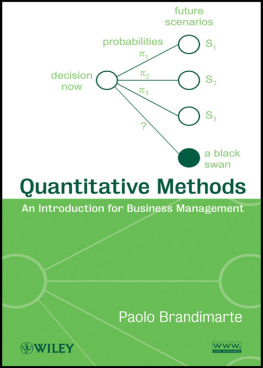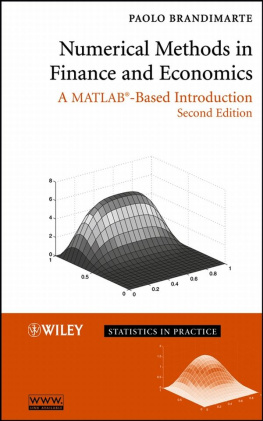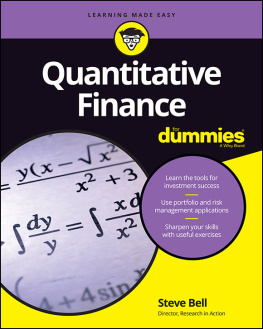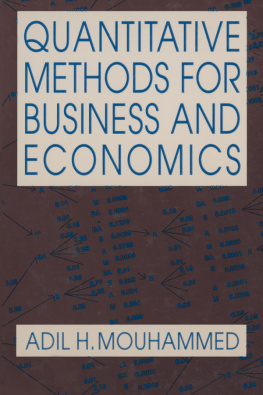Brandimarte - Quantitative Methods
Here you can read online Brandimarte - Quantitative Methods full text of the book (entire story) in english for free. Download pdf and epub, get meaning, cover and reviews about this ebook. year: 2011, publisher: Wiley, genre: Romance novel. Description of the work, (preface) as well as reviews are available. Best literature library LitArk.com created for fans of good reading and offers a wide selection of genres:
Romance novel
Science fiction
Adventure
Detective
Science
History
Home and family
Prose
Art
Politics
Computer
Non-fiction
Religion
Business
Children
Humor
Choose a favorite category and find really read worthwhile books. Enjoy immersion in the world of imagination, feel the emotions of the characters or learn something new for yourself, make an fascinating discovery.
- Book:Quantitative Methods
- Author:
- Publisher:Wiley
- Genre:
- Year:2011
- Rating:4 / 5
- Favourites:Add to favourites
- Your mark:
- 80
- 1
- 2
- 3
- 4
- 5
Quantitative Methods: summary, description and annotation
We offer to read an annotation, description, summary or preface (depends on what the author of the book "Quantitative Methods" wrote himself). If you haven't found the necessary information about the book — write in the comments, we will try to find it.
Quantitative Methods — read online for free the complete book (whole text) full work
Below is the text of the book, divided by pages. System saving the place of the last page read, allows you to conveniently read the book "Quantitative Methods" online for free, without having to search again every time where you left off. Put a bookmark, and you can go to the page where you finished reading at any time.
Font size:
Interval:
Bookmark:

Quantitative Methods

Copyright 2011 by John Wiley & Sons, Inc. All rights reserved
Published by John Wiley & Sons, Inc., Hoboken, New Jersey
Published simultaneously in Canada
No part of this publication may be reproduced, stored in a retrieval system, or transmitted in any form or by any means, electronic, mechanical, photocopying, recording, scanning, or otherwise, except as permitted under Section 107 or 108 of the 1976 United States Copyright Act, without either the prior written permission of the Publisher, or authorization through payment of the appropriate per-copy fee to the Copyright Clearance Center, Inc., 222 Rosewood Drive, Danvers, MA 01923, (978) 750-8400, fax (978) 750-4470, or on the web at www.copyright.com . Requests to the Publisher for permission should be addressed to the Permissions Department, John Wiley & Sons, Inc., 111 River Street, Hoboken, NJ 07030, (201) 748-6011, fax (201) 748-6008, or online at http://www.wiley.com/go/permission .
Limit of Liability/Disclaimer of Warranty: While the publisher and author have used their best efforts in preparing this book, they make no representations or warranties with respect to the accuracy or completeness of the contents of this book and specifically disclaim any implied warranties of merchantability or fitness for a particular purpose. No warranty may be created or extended by sales representatives or written sales materials. The advice and strategies contained herein may not be suitable for your situation. You should consult with a professional where appropriate. Neither the publisher nor author shall be liable for any loss of profit or any other commercial damages, including but not limited to special, incidental, consequential, or other damages.
For general information on our other products and services or for technical support, please contact our Customer Care Department within the United States at (800) 762-2974, outside the United States at (317) 572-3993 or fax (317) 572-4002.
Wiley also publishes its books in a variety of electronic formats. Some content that appears in print may not be available in electronic formats. For more information about Wiley products, visit our web site at www.wiley.com .
Library of Congress Cataloging-in-Publication Data :
Brandimarte, Paolo.
Quantitative methods : an introduction for business management / Paolo Brandimarte.
p. cm.
Includes bibliographical references and index.
ISBN 978-0-470-49634-3 (hardback)
1. ManagementMathematical models. I. Title.
HD30.25.B728 2011
658.0072-dc22
2010045222
Preface
And there I was, waiting for the big door to open, the big door that stood between me and my archnemesis. I found little comfort and protection, if any, sitting in what seemed my thin tin tank, looking around and searching for people in my same dire straits. Then, with a deep rumble, the big steel door of the ship opened, engines were started, and I followed the slow stream of cars. I drove by rather uninterested police officers, and there it was, my archnemesis: the first roundabout in Dover.
For European continental drivers like me, used to drive on the right side of the street (and yes, I do mean right ), the first driving experience in the Land of Albion has always been a challenge. That difficulty compounded with the lack of roundabouts in Italy at the time, turning the whole thing into sheer nightmare. Yet, after a surprisingly short timespan, maybe thanks to the understanding and discipline of the indigenous drivers, I got so used to driving there, and to roundabouts as well, that after my return to Calais I found driving back in supposedly familiar lanes somewhat confusing.
I had overcome my fear, but I am digressing, am I? Well, this book should indeed be approached like a roundabout: There are multiple entry and exit points, and readers are expected to take their preferred route among the many options, possibly spinning a bit for fun. I should also mention that, however dreadful that driving experience was to me, it was nothing compared with the exam labor of my students of the terrifying quantitative methods course. I hope that this book will help them, and many others, to overcome their fear. By the same token, I believe that the book will be useful to practitioners as well, especially those using data analysis and decision support software packages, possibly in need of a better understanding of those black boxes.
I have a long teaching experience at Politecnico di Torino, in advanced courses involving the application of quantitative methods to production planning, logistics, and finance. A safe spot, indeed, with a fairly homogeneous population of students. Add to this the experience in teaching numerical methods in quantitative finance masters programs, with selected and well-motivated students. So, you may imagine my shock when challenged by more generic and basic courses within a business school (ESCP Europe, Turin Campus), which I started teaching a few years ago. The subject was quite familiar, quantitative methods, with much emphasis on statistics and data analysis.
However, the audience was quite different, as the background of my new students ranged from literature to mathematics/engineering, going through law and economics. When I wondered about how not to leave the whole bunch utterly disappointed, the mission impossible theme started ringing in my ears. I must honestly say that the results have been occasionally disappointing, despite my best efforts to make the subject a bit more exciting through the use of business cases, a common mishap for teachers of technical subjects at business schools. Yet, quite often I was delighted to see apparently hopeless students struggle, find their way, and finally pass the exam with quite satisfactory results. Other students, who had a much stronger quantitative background, were nevertheless able to discover some new twists in familiar topics, without getting overly bored. On the whole, I found that experience challenging and rewarding.
On the basis of such disparate teaching experiences, this possibly overambitious book tries to offer to a hopefully wide range of readers whatever they need.
- Part I consists of three chapters. Chapter 1 aims at motivating the skeptical ones. Then, I have included two chapters on calculus and linear algebra. Advanced readers will probably skip them, possibly referring back to refresh a few points just when needed, whereas other students will not be left behind. Not all the material provided there is needed; in particular, the second half of Chapter 3 on linear algebra is only necessary to tackle Parts III and IV.
- Part II corresponds to the classical core of a standard quantitative methods course. Chapters 410 deal with introductory topics in probability and statistics. Readers can tailor their way through this material according to their taste. Especially in later chapters, they can safely skip more technical sections, which are offered to more mathematically inclined readers. Both Chapter 9, on inferential statistics, and Chapter 10, on linear regression, include basic and advanced sections, bridging the gap between cookbook-oriented texts and the much more demanding ones. Also Chapter 11, on time series, consists of two parts. The first half includes classical topics such as exponential smoothing methods; the second half introduces the reader to more challenging models and is included to help readers bridge the gap with the more advanced literature without getting lost or intimidated.
Font size:
Interval:
Bookmark:
Similar books «Quantitative Methods»
Look at similar books to Quantitative Methods. We have selected literature similar in name and meaning in the hope of providing readers with more options to find new, interesting, not yet read works.
Discussion, reviews of the book Quantitative Methods and just readers' own opinions. Leave your comments, write what you think about the work, its meaning or the main characters. Specify what exactly you liked and what you didn't like, and why you think so.











